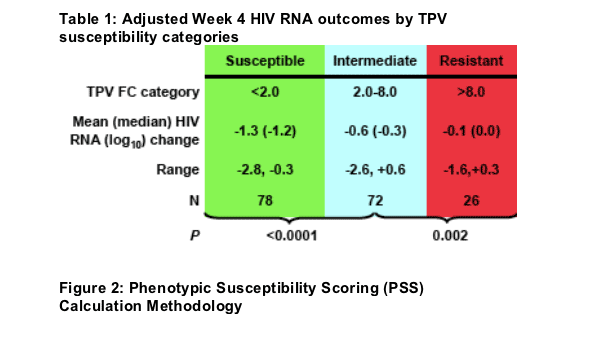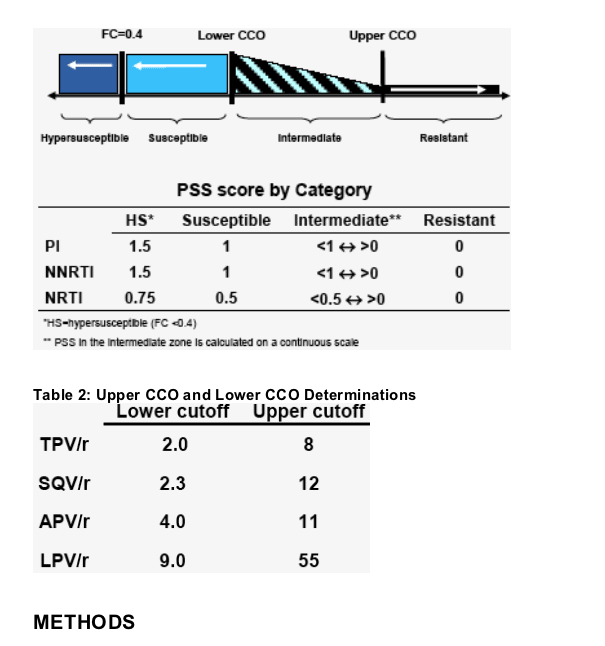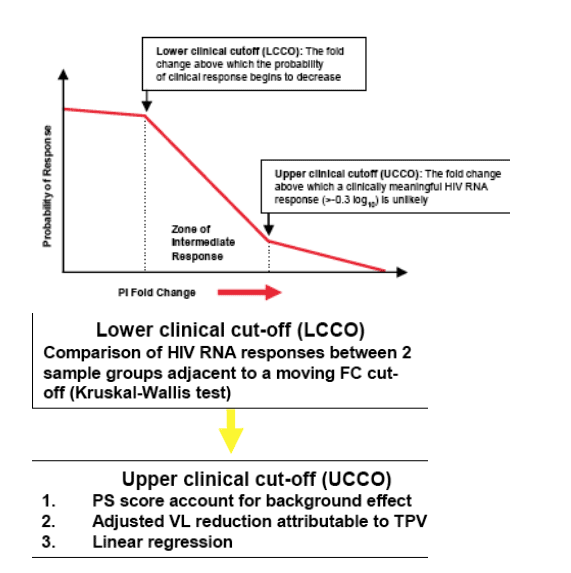 |
 |
 |
| |
Defining Lower (L) and Upper (U) Phenotypic Clinical Cutoffs (CCO's) for Tipranavir/r (TPV), Lopinavir/r (LPV), Saquinavir (SQV) and Amprenavir (APV) Co-Administered with Ritonavir (r) Within the RESIST Dataset by the PhenoSense Assay
|
| |
| |
Reported by Jules Levin
ICAAC, Sept 2006, San Francisco
E. P. COAKLEY1, C. CHAPPEY1, P. FLANDRE2, R. PESANO1,
N. PARKIN1, V. KOHLBRENNER3, D. B. HALL3, D. L. MAYERS3
1Monogram Biosciences, South San Francisco, CA
2INSERM, Paris, France, 3Boehringer Ingelheim, Ridgefield, CT
H-995 #398
BACKGROUND:
The RESIST trials compared the efficacy of TPV/r to that of other PI/r in 3-class experienced individuals. We defined the UCCO and LCCO for TPV, LPV, SQV and APV within this dataset by evaluating week 4 (W4) HIV RNA outcomes.
Within the final adjusted HIV RNA distribution the FC corresponding to -0.3 log10
copies/mL HIV RNA change was identified as the UCCO.
RESULTS
The numbers of samples analyzed per arm were TPV/r=176, APV/r=112, LPV/r=94 and SQV/r= 87.
A TPV CO was defined within the distribution of WT TPV susceptibilities. To avoid misclassification of WT viruses as resistant a LCCO of 2.0, at the limit of the WT distribution was chosen. After adjusting for the impact of background therapy the UCCO for TPV was defined at 8.0.
The mean adjusted Week 4 HIV RNA changes among TPV susceptible, intermediate and resistant -1.6, -0.6 and -0.1 log10 c/mL , respectively.
LCCO/UCCO for, LPV, SQV and APV were defined at 9/55, 2.3/12, and 4/11, respectively.
Application of these LCCO/UCCO to the 563 baseline RESIST study samples phenotyped demonstrated that the proportions of samples fully susceptible to TPV, LPV, SQV and APV were 53%, 18%, 17% and 26%, respectively.
By contrast the proportions resistant to TPV, LPV, SQV and APV were 12%, 55%, 56% and 49%, respectively.
Among those with intermediate susceptibility to LPV, SQV and APV the proportions fully susceptible to TPV were 55%, 66%, and 59%, respectively.
CONCLUSIONS
These analyses define the LCCO and UCCO for TPV/r (2/8), LPV/r (9/55), SQV/r (2.3/12), and APV/r (4/11) by the PhenoSense assay within the Resist dataset
The unique susceptibility profile of TPV relative to the comparator PI is highlighted within this data set where the proportions fully susceptible to TPV, APV, LPV and SQV were 53%, 26%, 18% and 17%, respectively.



Baseline samples were selected from regimens where the new regimen did not include enfuvirtide, and where the study PI/r was not a continuation of the prestudy PI/r. The study PI/r evaluated were TPV/r, LPV/r, SQV/r and APV/r. In the TPV/r arm samples were selected such that 50% had a TPV mutation score >4 and 50% had scores <4.
Linear regression was used to quantify the correlation between the baseline TPV fold change (log10 transformed FC) and the absolute HIV RNA reduction (log10 copies (c)/mL) from baseline (start of the study, or day 0) to week 4. For a total of 176 patient data points, the correlation was positive with a R2 of 0.22 (p<0.0001).
Biological Cut-Off: For any given ARV the biological cut-off is at the 99th centile for the fold-change distribution for isolates within the Monogram database which do not have genotypic resistance in protease or reverse transcriptase. For TPV 556 isolates were identified and used to define the biologic cutoff at 2.1.
Lower Clinical Cut-Off (LCCO): The LCCO was defined as the fold change at which the HIV RNA response is first observed to decrease. This was estimated as the lowest fold change corresponding to a statistically significant decline of HIV RNA response relative to the more susceptible reference population. To define the fold change that verifies this definition of LCCO, we used of a moving window approach and ran successive statistical tests for increasing fold change. The method comprised 4 steps: 1) Defining 2 continuous windows, adjacent at a given fold-change CO, and encompassing the same number of patients data points, 2) Computing the median HIV RNA reduction within the left and right windows, 3) Testing for the statistical significance of the difference between the responses (Kruskal-Wallis), 4) Moving the CO and expanding the window's limits.
The fold-change CO started at 1 and increased by 0.1. At the start, the windows encompassed 31 data points in the left and right windows. As CO increased, the left window expanded encompassing additional data points. The right-limit of the right windows was moved rightward to include the match the number of data points in the left window. Also, we evaluated a fixed window approach, encompassing a total of fixed number of data points on the left and the right windows at each step, this number being determined by the number of samples below the first tested CO, e.g., 31 for TPV.
Upper Clinical Cut-Off (UCCO): This was defined as the FC above which the week 4 HIV RNA reduction from baseline was less than 0.3 log10c/mL. The contribution of the background therapy in explaining limited HIV RNA response is particularly important for this analysis. To quantify the relative contribution of PI/r and other background therapy, a continuous phenotypic susceptibility score (cPSS) was derived for each of the 'new' drugs in the study regimen, where 'new' drugs were those that were not used in the prestudy regimen. The new regimen cPSS was derived from the sum of the PSS for each new drug. The attributable HIV RNA change for each drug was determined by the relative proportion of the total PSS.
The scoring for the individual drugs is derived as part of an ongoing iterative process employing data from previously described PSS studies (1-4). Viruses fully resistant to a given drug were assigned a null score for that drug. A score of 1 was assigned for viruses fully susceptible to a PI/r or NNRTI and of 0.5 for
viruses fully susceptible to an NRTI. For viruses with FC's <0.4, i.e., hypersusceptible, a value of 1.5 (PI/r, NNRTI) or 1 (NRTI) was assigned. For viruses with susceptibilities in the intermediate zone the score value was assigned on a continuous scale proportionate to the distance of the FC between the upper and lower CO's.
Since the PI UCCO was not know sequentially higher upper cut-offs were evaluated, the PSS and HIV RNA distribution adjusted accordingly. Samples with FC >UCCO tested were censored from the analysis. The selected upper cut-off was that associated with the best fit by linear regression. Within this adjusted
data distribution the PI fold change corresponding to a -0.3 log10c/ml HIV RNA change from baseline was identified and defined the upper cutoff
|
| |
|
 |
 |
|
|